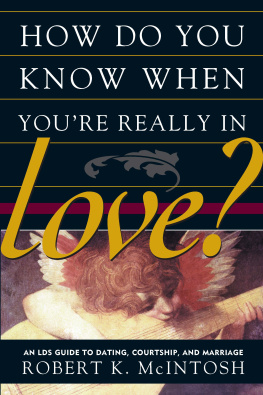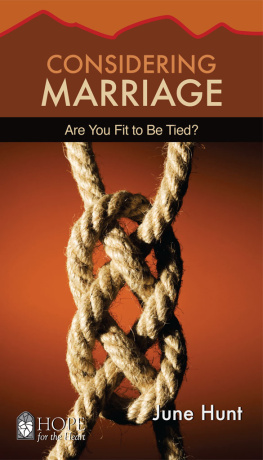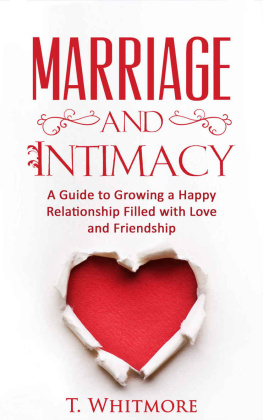How Do You Know When You're Really In Love?
An LDS Guide to Dating, Courtship, and Marriage
Robert K. McIntosh
2000 Robert K. McIntosh.
All rights reserved. No part of this book may be reproduced in any form or by any means without permission in writing from the publisher, Deseret Book Company (permissions@deseretbook.com), P.O. Box 30178, Salt Lake City Utah 84130. This work is not an official publication of The Church of Jesus Christ of Latter-day Saints. The views expressed herein are the responsibility of the author and do not necessarily represent the position of the Church or of Deseret Book. Deseret Book is a registered trademark of Deseret Book Company.
Bookcraft is a registered trademark of Deseret Book Company.
Visit us at DeseretBook.com
Library of Congress Cataloging-in-Publication Data
McIntosh, Robert K., 1942
How do you know when youre really in love? / Robert K. McIntosh.
p. cm.
Includes bibliographical references.
ISBN 978-1-57345-647-0 (pbk.)
1. MarriageReligious aspectsChurch of Jesus Christ of Latter-day Saints. 2. LoveReligious aspectsChurch of Jesus Christ of Latter-day Saints. 3. Young adultsReligious life. I. Title.
BX8641 .M39 2000
248.489332dc2100-021325
Printed in the United States of America
R. R. Donnelley and Sons, Allentown, PA
To Susans and my grandchildrenthose born and those yet unborn:
Robert, Kacie, Madison, and Morgan McIntosh
Kennedy, Connor, Aidan, Fiona, and Bridgett McIntosh
Brittany Ware
Tyler, Alexander, and Paris Lukes
Austin Jordan, Baylee, and Carter Boden
Brooklyn, Christian, and Chole McIntosh
You are the joy and the light of our lives. Our greatest hope and prayer is that in eternity there will be no empty chairs.
Acknowledgments

Most books are the results of the efforts, not just of the author, but of many people. This is certainly the case with this book. I would like to sincerely thank the following:
Prophets and Church leaders, past and present, for their inspiration, guidance, and example relative to the principles in this book. I hope I have represented well their teachings.
Shirley R. Klein, Dale E. LeBaron, Howard Hamilton, Douglas E. Brinley, William O. Nelson, and Lee Benson, for their careful review, insights, and editing of the manuscript.
Leonard Tourney, who acted as a sounding board and adviser for many of the ideas in this book.
Frederick G. Williams, for helping me understand the nature of godly love, through discussions and through his example.
Cory Maxwell and staff, for having faith and confidence that this book might make a difference in the lives of young people.
Richard Peterson, for his skillful edit of the manuscript.
Nanci Gardiner, for typing the manuscript and for her constant encouragement.
The Church Educational System, for allowing me to serve some of the finest youth in the Church.
My many students and friends of the past thirty years. Thank you for all you have taught me and for the example you have been of the teachings of Jesus Christ.
Our children, their companions, and our wonderful grandchildren. From you I have learned a dimension of love that has blessed my life eternally.
Susan, for being my friend, eternal companion, and example of all that is good in this book. Thank you for loving me.
Finally, I take full responsibility for the errors and omissions in this book. All that is good is the result of the contributions of those I have mentioned.
Introduction

To attempt to define and understand love is a most challenging task! A song from my youth acknowledges the difficulty by asking, Who can explain it, who can tell you why? And concluding, Fools give you reasons, wise men never try.
And yet love is vital to our lives and to the gospel of Jesus Christ, for the scriptures teach that God is love (). So it must be possible to gain some understanding of this wonderful phenomenon, which philosophers, religious leaders, writers, and poets have grappled with since time began. Sometimes they have diagrammed stages of love, and other times they have drawn comparisons showing what love is and what it isnt. One thing is certain: there are many dimensions to love. Like a diamond, it is multifaceted and not just one thing.
One Latter-day Saint leader, Elder Joe J. Christensen of the First Quorum of the Seventy, borrowed from the Greek lexicon to describe three dimensions of love. In his insightful discussion of this subject, Elder Christensen says one Greek word for love is eros, which suggests romantic love. This is the kind of love that exists between a man and a woman. It involves the affectionate feelings that initially attract two people to each other and which are so vital in courtship and in the strengthening of marital bonds. The English word erotic comes from that Greek root.
The second category of love is philia. The emotions involved here are those we are capable of feeling for our parents, siblings, relatives, friends, neighbors, and associates. It is to this the Lord referred when he commanded us to love our neighbors. Philadelphia, which calls itself the City of Brotherly Love, derives its name from this Greek root.
Finally, the Greeks differentiated a third type of loveagape. This is godlike love, of the type manifested in Deitys capacity to love us in spite of our deficiencies. This is the word used in the Greek text of the New Testament each time the Lord commands us to love our enemies. It is also the type of love that allows us to overlook our companions faults or shortcomings and to freely forgive offenses.
Some people have construed these three dimensions of love as stages, one rising to another. To do so makes one dimension of love appear to be more important than another. In my experience, a broader view of love takes into consideration all three of these dimensions, although there may be times when one aspect is stressed more than another in our lives. For example, the romantic nature of love is clearly more dominant in the period of courtship, but it should remain an integral part of the relationship throughout the marriage.
Living the gospel provides an analogy of how these three aspects of love are related. A gospel-centered life is one where our physical, social, intellectual, emotional, and spiritual dimensions are all integrated. So it is with love. Love encompasses the physical, social, intellectual, emotional, and spiritual aspects of our lives. Using Elder Christensens description of love, romantic love would be the physical aspect; friendship love would include the social, intellectual, and emotional aspects; and Christlike love would involve the spiritual. A diagram of love that encompasses all three dimensions looks like this:

In this book I will attempt, with the help and guidance of the standard works and the teachings of Church leaders, to describe each of these dimensions of love. In doing so, I will not attempt to interpret doctrine, for that is the province of the First Presidency of the Church. We will also examine Satans half-truths about love, in an effort to expose his tactics as he labors to make us as miserable as he is. I will also discuss the importance of preparing for a celestial marriage so that you can be worthy of and attract the type of person that you will love forever. We will look closely at how we properly go about choosing a marriage partner, bearing in mind the enormous importance of the temple in this regard. One of the most important questions we will explore is Am I in love enough to marry? By this I mean are you in love enough to accept all of the demands of married lifefinancial, physical, emotional, and spiritual?














